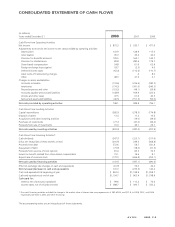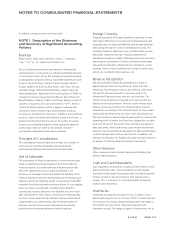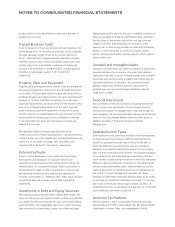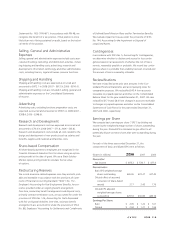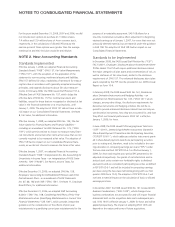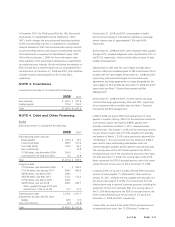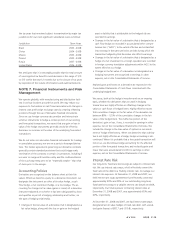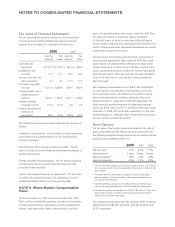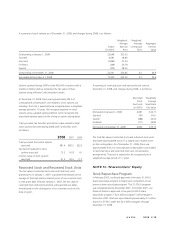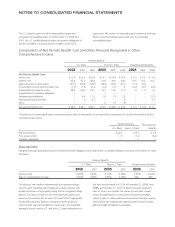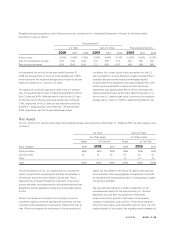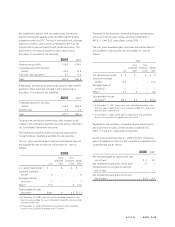Avon 2008 Annual Report Download - page 67
Download and view the complete annual report
Please find page 67 of the 2008 Avon annual report below. You can navigate through the pages in the report by either clicking on the pages listed below, or by using the keyword search tool below to find specific information within the annual report.
the tax years that remained subject to examination by major tax
jurisdiction for our most significant subsidiaries were as follows:
Jurisdiction Open Years
Brazil 2003 - 2008
China 2004 - 2008
Mexico 2003 - 2008
Poland 2003 - 2008
Russia 2007 - 2008
United States 2006 - 2008
We anticipate that it is reasonably possible that the total amount
of unrecognized tax benefits could decrease in the range of $10
to $15 within the next 12 months due to the closure of tax years
by expiration of the statute of limitations and audit settlements.
NOTE 7. Financial Instruments and Risk
Management
We operate globally, with manufacturing and distribution facili-
ties in various locations around the world. We may reduce our
exposure to fluctuations in cash flows associated with changes in
interest rates and foreign exchange rates by creating offsetting
positions through the use of derivative financial instruments.
Since we use foreign currency-rate sensitive and interest-rate
sensitive instruments to hedge a certain portion of our existing
and forecasted transactions, we expect that any gain or loss in
value of the hedge instruments generally would be offset by
decreases or increases in the value of the underlying forecasted
transactions.
We do not enter into derivative financial instruments for trading
or speculative purposes, nor are we a party to leveraged deriva-
tives. The master agreements governing our derivative contracts
generally contain standard provisions that could trigger early
termination of the contracts in certain circumstances, including if
we were to merge with another entity and the creditworthiness
of the surviving entity were to be “materially weaker” than that
of Avon prior to the merger.
Accounting Policies
Derivatives are recognized on the balance sheet at their fair
values. When we become a party to a derivative instrument, we
designate the instrument as either a fair value hedge, a cash
flow hedge, a net investment hedge, or a non-hedge. The ac-
counting for changes in fair value (gains or losses) of a derivative
instrument depends on whether it has been designated by Avon
and qualifies as part of a hedging relationship and further, on
the type of hedging relationship.
• Changes in the fair value of a derivative that is designated as a
fair value hedge, along with the loss or gain on the hedged
asset or liability that is attributable to the hedged risk are
recorded in earnings.
• Changes in the fair value of a derivative that is designated as a
cash flow hedge are recorded in accumulated other compre-
hensive loss (“AOCI”) to the extent effective and reclassified
into earnings in the same period or periods during which the
transaction hedged by that derivative also affects earnings.
• Changes in the fair value of a derivative that is designated as a
hedge of a net investment in a foreign operation are recorded
in foreign currency translation adjustments within AOCI to the
extent effective as a hedge.
• Changes in the fair value of a derivative not designated as a
hedging instrument are recognized in earnings in other
expense, net on the Consolidated Statements of Income.
Realized gains and losses on a derivative are reported on the
Consolidated Statements of Cash Flows consistent with the
underlying hedged item.
We assess, both at the hedge’s inception and on an ongoing
basis, whether the derivatives that are used in hedging
transactions are highly effective in offsetting changes in fair
values or cash flows of hedged items. Highly effective means
that cumulative changes in the fair value of the derivative are
between 80% – 125% of the cumulative changes in the fair
value of the hedged item. The ineffective portion of the
derivative’s gain or loss, if any, is recorded in earnings in other
expense, net on the Consolidated Statements of Income. We
include the change in the time value of options in our assess-
ment of hedge effectiveness. When we determine that a deriva-
tive is not highly effective as a hedge, hedge accounting is dis-
continued. When it is probable that a forecasted transaction will
not occur, we discontinue hedge accounting for the affected
portion of the forecasted transaction, and reclassify gains and
losses that were accumulated in AOCI to earnings in other
expense, net on the Consolidated Statements of Income.
Interest Rate Risk
Our long-term, fixed-rate borrowings are subject to interest rate
risk. We use interest rate swaps, which effectively convert the
fixed rate on the debt to a floating interest rate, to manage our
interest rate exposure. At December 31, 2008 and 2007, we
held interest rate swap agreements that effectively converted
approximately 50% and 30% of our outstanding long-term,
fixed-rate borrowings to a variable interest rate based on LIBOR,
respectively. Our total exposure to floating interest rates at
December 31, 2008 and 2007, was approximately 65% and
60%, respectively.
At December 31, 2008 and 2007, we had interest rate swaps
designated as fair value hedges of fixed-rate debt, with unreal-
ized gains (losses) of $83.7 and ($10.8), respectively.
A V O N 2008 F-15


